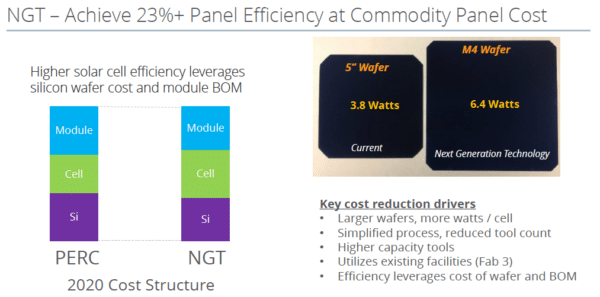In 2018, the solar technology of the past is not good enough. Just as solar manufacturer First Solar has undergone a massive retooling to move to its larger-format Series 6 module, U.S. rival SunPower is preparing for a major shift to its new NGT technology, as revealed in yesterday’s second quarter results call.
The call also revealed some of the only details SunPower has released on NGT technology. Like its Maxeon solar cells, NGT will be based on interdigitated back contact (IBC) technology, but using larger-format six-inch wafers.
SunPower has no plans for new fabs to make NGT and announced it plans to convert all its 800 MW of E-Series cell and module production to the new product. Chief executive Tom Werner says NGT is “ahead of plan” and the company has already produced the first silicon on a new line at its Fab 3 in Malaysia.
The company expects to begin volume production in the fourth quarter, and says the technology will substantially reduce the cost of its products, noting a simplified process with fewer tools and higher capacity.
“When fully ramped, we believe that NGT cost per watt will be on par with mono-PERC technology,” said Werner on the results call.

At the same time, SunPower reported very high efficiencies similar to its Maxeon products, projecting modules using its NGT cells will offer greater than 23% efficiency. Any wattage gains will be mostly due to larger wafers, however Mr. Werner told pv magazine there are “some subtle changes to get the efficiency up due to the geometry on the back side of the cell”.
SunPower has not released information on the format of the modules to be made with NGT cells, but Mr. Werner said there may be a slightly larger format, in line with existing trends.
The CEO also stated the company has not made a decision on whether or when it will switch over its 400 MW of X Series production to NGT, given its Fab 4 in the Philippines is only two years old.
Cash ins and outs
The decision to phase out the E-Series, however, was not kind to SunPower’s Q2 results. The company wrote down $369 million of its legacy manufacturing equipment, the largest factor in the company’s stunning three-month loss of $447 million, which all but equalled revenue of $449 million for the quarter. SunPower also reported a sizable $68 million in impairment of its lease assets – when those two red entries are stripped out of the figures, the company pretty much broke even.
SunPower has also been paying off debt so its balance sheet shows less than $300 million in cash, and the company is furiously selling off ‘non-essential' parts of its business. That included the sale of a stake in yieldco 8point3 Energy Partners and its microinverter technology, and now SunPower expects to monetize the first phase of its lease portfolio. By the end of the year the company expects to sell 400 MW of residential lease assets.
Financing question mark
Even with those provisions though, it is not clear how SunPower is going to pay for a massive retooling and the acquisition of a factory.
The good news is the company expects to limit retooling costs by using existing factories rather than making NGT in greenfield factories. That does not mean that the cost will not be significant though; Mr. Werner estimates a bill of $0.30 per watt to retool its Fab 3 for NGT production, meaning a total cost of more than $1 billion given the higher capacity after the switch. The company plans to fund that at least in part through customer advances and partnerships, and says it has several in the works.
There is also the substantial matter of the pending acquisition of SolarWorld’s Oregon factory, which SunPower also plans to fund without new capital – here the sale of assets could prove critical. Retooling at the SolarWorld factory is expected to be much less costly, as the company plans to use SolarWorld’s cell production and the biggest change will be moving module production to the P-Series.
In fact SunPower may not have much of a choice. Like all PV manufacturers it faces an existential threat from global oversupply stemming from May's Chinese policy changes, and is also staring down an estimated $51 million in tariffs on its products during the second half of the year.
SunPower has a choice to go big or go home – it is choosing the former.
This content is protected by copyright and may not be reused. If you want to cooperate with us and would like to reuse some of our content, please contact: editors@pv-magazine.com.


By submitting this form you agree to pv magazine using your data for the purposes of publishing your comment.
Your personal data will only be disclosed or otherwise transmitted to third parties for the purposes of spam filtering or if this is necessary for technical maintenance of the website. Any other transfer to third parties will not take place unless this is justified on the basis of applicable data protection regulations or if pv magazine is legally obliged to do so.
You may revoke this consent at any time with effect for the future, in which case your personal data will be deleted immediately. Otherwise, your data will be deleted if pv magazine has processed your request or the purpose of data storage is fulfilled.
Further information on data privacy can be found in our Data Protection Policy.